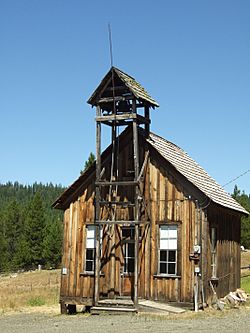Granite, Oregon facts for kids
Quick facts for kids
Granite, Oregon
|
|
|---|---|
 |
|

Location in Oregon
|
|
| Country | United States |
| State | Oregon |
| County | Grant |
| Incorporated | 1900 |
| Area | |
| • Total | 0.38 sq mi (0.98 km2) |
| • Land | 0.37 sq mi (0.96 km2) |
| • Water | 0.00 sq mi (0.01 km2) |
| Elevation | 4,672 ft (1,424 m) |
| Population
(2020)
|
|
| • Total | 32 |
| • Density | 86.02/sq mi (33.17/km2) |
| Time zone | UTC-8 (Pacific) |
| • Summer (DST) | UTC-7 (Pacific) |
| ZIP code |
97877
|
| Area code(s) | 458 and 541 |
| FIPS code | 41-30500 |
| GNIS feature ID | 2410642 |
Granite is a city in Grant County, in the U.S. state of Oregon. The city had a population of 38 in 2010, up from 24 in 2000. In 2010, it was the fourth-smallest incorporated city by population in Oregon. The smaller cities were Shaniko (36 people), Lonerock (21), and nearby Greenhorn (0).
Contents
History
First established by miners after the discovery of gold along Granite Creek on July 4, 1862, the area was originally called Granite Creek Mines. During the following year, a settlement called Granite City was established about 1.5 miles (2.4 km) downstream of where Granite City is now. It was moved to its current location in 1867 and renamed Independence after the date—July 4, or Independence Day—of the earlier gold discovery. However, when the community's post office was established in 1878, it could not use the name Independence because that name was already used by another Oregon city. Instead, the name Granite was chosen. The post office closed in 1957, but the city retained the name. The creek takes its name from the granite rocks that are common to the area.
The Ah Hee Diggings are located about one-mile north of the town.
In 1878, miner and business owner A. G. Tabor became the first postmaster. Grant Thornburg became the first mayor after the city incorporated in 1900.
A 1939 interview "Occupational and Social Life of Granite" recorded by William "Bill" Haight as part of the Federal Writers' Project, described the town and surroundings of Granite.
Economy
In 1942, during World War II, the War Production Board shut down gold mining in the United States via Order No. L-208. The board deemed gold mining to be non-essential to the war effort, and it wanted gold miners to mine "essential" metals instead. Since Granite depended so heavily on gold mining, its economy collapsed when the mines shut down. Telephone and electric services to Granite ceased after the war. From 86 residents in 1940, the city's population dropped to 2 in 1960.
By 1990, the population had grown again to 10. In 2000, the population reached 24, and telephone service was restored. As of 2002, Granite had two employers: The Outback—which sold food, fuel, and supplies—and The Lodge.
As of September 2017[update] the population remains at 24. The Outback and the Lodge also remain in business.
Geography
Granite is in the Blue Mountains of eastern Oregon. It is 47 miles (76 km) west of Baker City by highway and 346 miles (557 km) east-southeast of Portland. According to the United States Census Bureau, the city has a total area of 0.37 square miles (0.96 km2), all land.
The Elkhorn Drive Scenic Byway, a 106-mile (171 km) closed-loop route mainly through forests in the Elkhorn Mountains, passes through Granite. Other communities along the route are Baker City, Haines, and Sumpter, the latter about 11 miles (18 km) southeast of Granite.
Demographics
| Historical population | |||
|---|---|---|---|
| Census | Pop. | %± | |
| 1870 | 448 | — | |
| 1880 | 200 | −55.4% | |
| 1890 | 249 | 24.5% | |
| 1900 | 245 | −1.6% | |
| 1910 | 89 | −63.7% | |
| 1920 | 55 | −38.2% | |
| 1930 | 45 | −18.2% | |
| 1940 | 86 | 91.1% | |
| 1950 | 40 | −53.5% | |
| 1960 | 3 | −92.5% | |
| 1970 | 4 | 33.3% | |
| 1980 | 17 | 325.0% | |
| 1990 | 8 | −52.9% | |
| 2000 | 24 | 200.0% | |
| 2010 | 38 | 58.3% | |
| 2020 | 32 | −15.8% | |
| source: | |||
2010 census
As of the census of 2010, there were 38 people, 22 households, and 13 families residing in the city. The population density was about 103 inhabitants per square mile (40/km2). There were 88 housing units at an average density of 238 per square mile (92/km2). The racial makeup of the city was about 95% White and 5% Native American. Hispanic or Latino of any race were about 5% of the population.
There were 22 households, of which about 5% had children under the age of 18 living with them, 55% were married couples living together, 5% had a male householder with no wife present, and 41% were non-families. Thirty-two percent of all households were made up of individuals, and 9% had someone living alone who was 65 years of age or older. The average household size was about 1.7 and the average family size was about 2.
The median age in the city was 63 years. About 3% of residents were under the age of 18; none was between the ages of 18 and 24; 3% were from 25 to 44; 50% were from 45 to 64; and 45% were 65 years of age or older. The gender makeup of the city was 58% male and 42% female.
See also
 In Spanish: Granite (Oregón) para niños
In Spanish: Granite (Oregón) para niños

